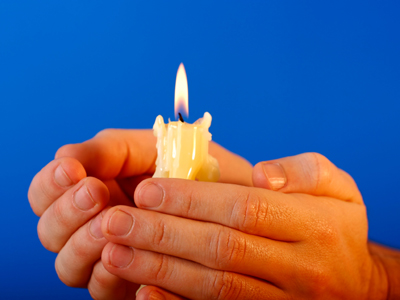
Ask the AI Tutor
Need help with Light? Ask our AI Tutor!
AI Tutor - Lucy
Connecting with Tutor...
Please wait while we establish connection

Light from a candle flame travels in straight lines.
Light
In KS2 Science, light is explored to understand how we see, how shadows are formed, and how light travels in straight lines through different materials.
1 .
Which of these is not a source of light?
A candle flame
The Sun
The Moon
A torch
The Moon does not produce any light - it only reflects the light of the Sun
2 .
Imagine a candle flame. Light from the candle flame travels in which direction?
In arcs
In straight lines
In random lines
All of the above
Light always travels in straight lines - we know this because a beam of light cannot curve around an object. If you hold a book between your eyes and the candle flame, you will not be able to see the flame - its light cannot travel through or around the book
3 .
Approximately, how fast does light travel?
120 kilometres per hour
3,000 kilometres per hour
3,000 kilometres per second
300,000 kilometres per second
Light travels faster than anything else - huge distances in space are described as 'light years'. Light travels the 150,000,000 kilometres from the Sun to the Earth in about eight minutes - can you imagine how far it could travel in a year?
4 .
Light travels slightly more slowly through air than through space. It is slowed down a little bit more by glass and which of the following?
Metal
Water
Concrete
Wood
Metal, concrete and wood are opaque materials that do not transmit light (let light pass through them)
5 .
How will a beam of light shining on a glass prism behave?
It will be refracted
It will be completely reflected
It will be completely absorbed
It will not be changed at all, instead being perfectly transmitted
When a beam of light shines on a glass prism, the light is refracted into its different colours, showing a 'rainbow' band of colours on the nearest white surfaces
6 .
If you half fill a clear glass with water and place a straw in the glass, how does the straw appear when you look at it carefully?
It appears normal
It seems to change colour
It appears bent or broken
It disappears completely
This interesting effect is caused by the refraction of light in the water
7 .
There are forms of light which are invisible to the human eye. Which of these is an example?
Ultraviolet
Reflections
Dark matter
Starlight
Ultraviolet (UV) light is visible to some insects and animals. Bumblebees can see UV light, for example
8 .
Visible light contains many colours. Which of the following is not one of these colours?
Green
Yellow
Black
Red
Visible, or 'white' light does not include the colour black. The colours of visible light are those of the rainbow (red, orange, yellow, green, blue, indigo, violet). Objects look black when they absorb all of the light shining on them
9 .
Why does a green apple look green?
It absorbs green light, but reflects the other colours
It reflects green light, but absorbs all of the other colours
It absorbs green light, but transmits all of the other colours
It transmits all of the light
The colour we see when we look at objects is the colour that is reflected by that object - all other colours are absorbed
10 .
A submarine's periscope allows someone on the boat to see objects that are above the water. How is this possible?
Light reflecting off the object curves as it enters the periscope
Light reflecting off the object is transmitted as it enters the periscope
Mirrors within the periscope reflect the light, enabling it to change direction
Periscope is another name for window
Modern submarines have replaced mirrors with prisms which can also magnify the reflections
**Unlimited Quizzes Await You! 🚀**
Hey there, quiz champ! 🌟 You've already tackled today's free questions.
Ready for more?
Ready for more?
🔓 Unlock UNLIMITED Quizzes and challenge yourself every day. But that's
not all...
not all...
🔥 As a Subscriber you can join our thrilling "Daily Streak" against other
quizzers. Try to win a coveted spot on our Hall of Fame Page.
quizzers. Try to win a coveted spot on our Hall of Fame Page.
Don't miss out! Join us now and keep the fun rolling. 🎉
**Unlimited Quizzes Await You! 🚀**
Hey there, quiz champ! 🌟 You've already tackled today's free questions. Ready for more?
🔓 Unlock UNLIMITED Quizzes and challenge yourself every day. But that's not all...
🔥 As a Subscriber you can join our thrilling "Daily Streak" against other quizzers. Try to win a coveted spot on our Hall of Fame Page.
Don't miss out! Join us now and keep the fun rolling. 🎉






